The Block Museum of Art and the McCormick School of Engineering at Northwestern University delve into the art and science of ancient artifacts in the exhibition “Paint the Eyes Softer: Mummy Portraits from Roman Egypt.”
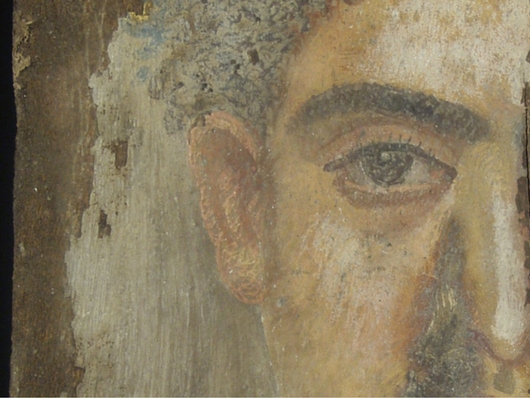 |
| Credit: The Block Museum of Art |
The groundbreaking installation was co-curated by Marc Walton, research professor of materials science and engineering at McCormick and senior scientist at NU-ACCESS (Northwestern University/ Art Institute of Chicago Center for Scientific Study in the Arts); Taco Terpstra, assistant professor of classics and history in Weinberg College of Arts and Sciences; and Essi Ronkko, Block Museum curatorial associate, working in consultation with a group of Northwestern undergraduate student researchers.
Ancient Portraits
A series of rare Roman-Egyptian funerary portraits on view within the exhibition were painted on wooden panels between the first and third centuries A.D. in Egypt. These visages of the dead were originally secured over the face of the deceased within the mummy wrappings.
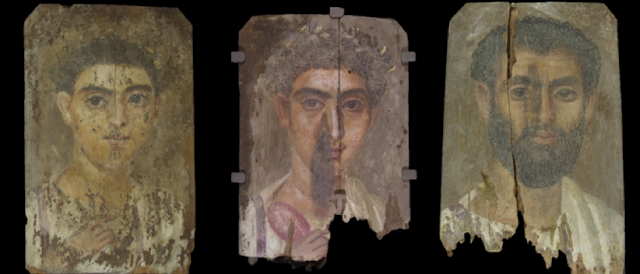 |
| Mummy portraits from Tebtunis, Fayum [Credit: Phoebe A. Hearst Museum of Anthropology and the Regents of the University of California] |
The majority of the objects on view at the Block, which were excavated from the site of Tebtunis (now Umm-el-Breigat, Egypt), are loans from the Phoebe A. Hearst Museum of Anthropology at the University of California, Berkeley. One of the largest collections of Roman portraits to have remained intact since excavation, they provide a rare opportunity to study the material microhistory of painting tradition in a known context and to explore how ancient paintings were created.
“It is extremely exciting to have not only a large number of rare mummy portraits on display but also the only known annotated sketch of what was to become yet another portrait,” Terpstra said. “It represents a moment frozen in time. We are witnessing the process of artistic creation, providing a unique experience for the curators as well as the visitors to the exhibit. I am really proud of both our Weinberg College and McCormick School students. They have done a fantastic job of getting the most out of this fascinating material.”
The Hibbard Mummy
The intact mummy of a young girl from the collection of Garrett-Evangelical Theological Seminary on the Northwestern University campus complements the Tebtunis portraits in the exhibition. This complete mummy with a portrait embedded in its wrappings comes from the site of Hawara, a site close to Tebtunis in the Fayum region of Egypt.
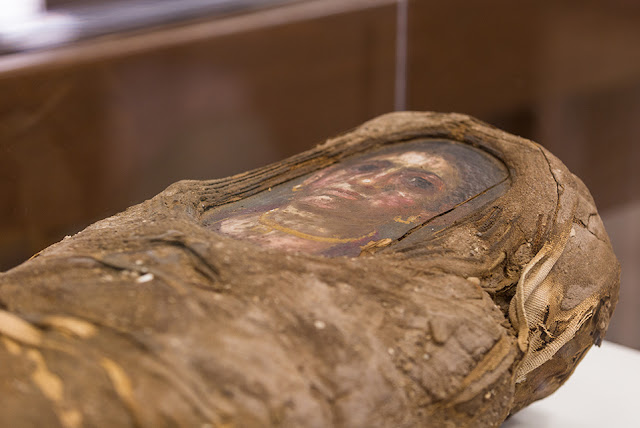 |
| The Hibbard mummy [Credit: Block Museum of Art] |
Rachel Sabino, associate conservator of objects in the department of conservation at the Art Institute of Chicago was the member of a multidisciplinary team of specialists who recently performed treatment on and oversaw handling, packing and transport of the Hibbard mummy.
“The extended period of study permitted a thorough evaluation of the mummy’s condition, and as a result of these interdisciplinary discussions, much of the overlying, encrusting burial soil was reduced in order to eliminate strain on the wrappings and to make the surface more uniformly responsive to environmental changes, thus providing for the mummy’s long-term stability,” Sabino said. “This action yielded the ancillary benefit of enhancing the mummy’s legibility by more clearly articulating the pattern of the underlying wrappings and differentiating them from secondary wrappings.”
Exhibition as Laboratory
In addition to the objects themselves, “Paint the Eyes Softer” highlights innovative techniques for the scientific study of objects. In recent years, the paintings have been the focus of a systematic study conducted by NUACCESS and UC Berkeley using a variety of imaging techniques. Recent scientific analysis conducted by NU-ACCESS has determined that some of the wood used in the creation of the panels was local, while some of it was brought in from the Balkans in southeastern Europe, opening interesting questions about ancient local economies and long-distance trade.
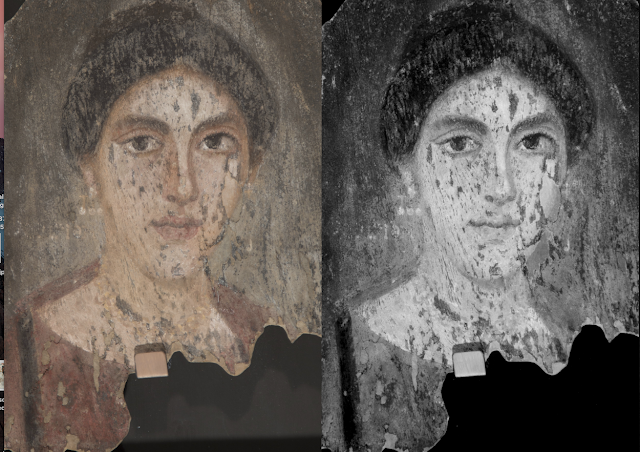 |
| VIS-NIR-Fluorescence comparison of Mummy portrait [Credit: Phoebe A. Hearst Museum of Anthropology and the Regents of the University of California and NU-ACCESS (6-21376)] |
As a capstone to this course, the students scientifically analyzed the Hibbard portrait mummy to collect meaningful scientific data. This materials-based approach provides new insights into the economic, historical and social context for art-making in the Fayum region and Roman Egypt.
The multidisciplinary course built upon findings from the research paper “A Roman Egyptian Painting Workshop: Technical Investigation of the Portraits from Tebtunis, Egypt,” authored by Walton and collaborators and published in the journal Archaeometry.
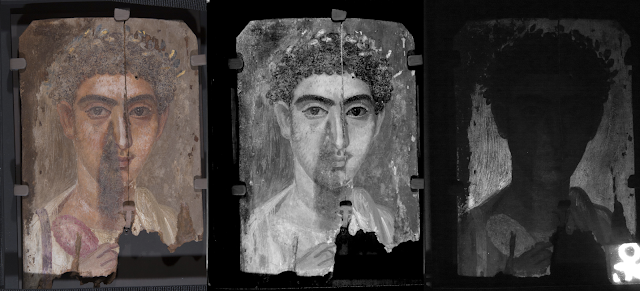 |
| VIS-NIR-Fluorescence comparison of Mummy portrait [Credit: Phoebe A. Hearst Museum of Anthropology and the Regents of the University of California and NU-ACCESS (6-2378b)] |
In addition, students in a seminar on sound design, taught by Northwestern professor Stephan Moore, developed a unique soundscape for the exhibition. Through presentations, discussions, field trips and technical demonstrations, they explored the current state of sound design for museum exhibitions. As a final project, the students created a fully realized soundscape for the exhibition.
Interdisciplinary research
The exhibition is presented as part of an ongoing art and engineering partnership between McCormick and the Block Museum that has included visiting artists, exhibitions and residencies focused on the productive intersections of creativity and scientific research.
“This unique exhibition is quintessentially Northwestern, arising from the DNA of the institution that values partnership and interdisciplinary inquiry,” said Lisa Corrin, the Block Museum Ellen Philips Katz Director. “Our students and faculty are able to come to significant, field-advancing findings by collaborating across multiple fields of expertise.
“This exhibition not only brings to Northwestern some of the most significant early portraits in existence, but demonstrates the way that art and engineering can come together in extraordinary ways,” Corrin said.
“This exhibit is just one of the many ways we are continuing to expand the intersection between art and engineering,” McCormick dean Julio M. Ottino said. “In addition to providing the tools of engineering to study the history of art, our partnership provides opportunities for engineers and artists to learn how each other works and thinks, expanding their own abilities in the process.”
The exhibition runs from January 13 - April 22, 2018.
Source: The Block Museum of Art [January 10, 2018]
